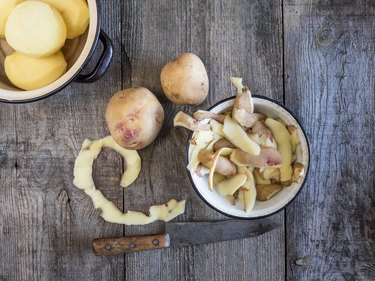
If you're like a growing percentage of the public, you're increasingly concerned about food waste and the chemicals with which many foods are said to be grown. One way to tackle both of those problems at once is to get as much as you can out of food scraps, like potato (Solanum tuberosum) peels, which some folks claim are a great fertilizer for your garden. The answer is a bit more complicated than that.
Can Potato Peels Fertilize Gardens?
Video of the Day
In theory, potato skins can fertilize gardens since they're packed with great stuff like potassium and phytonutrients, which plants like. So, why not just throw the peelings on the soil and get all those minerals and nutrients into the soil?
Video of the Day
For starters, that's exactly the sort of thing that attracts pests looking for an easy meal. To you, it's waste. To them, it's takeout, and who doesn't love takeout? Rats, deer, rabbits and other relentless garden-destroying critters are all drawn to scattered food clippings in a garden.
This is why composting is such an important science to understand if you're big on gardening. With regular care and oversight, good composting can make your soil as rich and nutritious as it can be for supporting plant life of all kinds and without summoning garden-destroying pests seeking an easy snack. Potato scraps can be composted, which means you can convert all that rich potato skin into enriched soil for gardening.
The Danger of Potato Blight
Composting potatoes of any kind is a risky business. Have you ever heard of potato blight? It's what caused the Great Irish Famine that killed over a million people in just under five years.
Potato blight is like a cancer for potatoes. Rot or mildew spots inside the flesh or on the foliage of the plant can be extremely contagious if it is reintroduced into the soil through composting or discarding scraps. It can spread far and wide in soil, spoiling whole crops and tainting soil for as long as four years. It's how the famine was so rampant in Ireland and wiped out the nation's greatest crop for nearly a half decade.
If potatoes have any brown spots or rot anywhere inside the flesh or on the skins, they cannot be added to your garden in any way, as this is a sign of blight. In fact, blight is why it's risky to compost potato plant foliage and why you should burn the foliage instead. Flesh can be composted if you're vigilant about watching for blight.
Stop the Spread of Blight
Keep your spuds in a dark, cool spot and always wash them well before peeling them. If you notice any gray or brown areas in the flesh during peeling or cutting, don't compost those peels or put them on your garden. Late blight for both tomatoes and potatoes has become a serious concern for all gardeners in recent years, but using scraps from healthy, clean potatoes for composting can be done safely.
Composting is as old as gardening itself and is a great way to do your bit for climate change while getting the healthiest garden you've ever had. One celebrated book to teach you the ropes is Let it Rot! The Gardener's Guide to Composting, by Stu Campbell. You can also use a compost accelerator recipe to start a compost heap quickly and effectively.
In the meantime, why not save the water in which you boiled your potatoes? Don't salt it, of course. Let it cool and then use it to water your garden. It's a great way to give some of those nutrients and minerals back to your garden — without the blight.